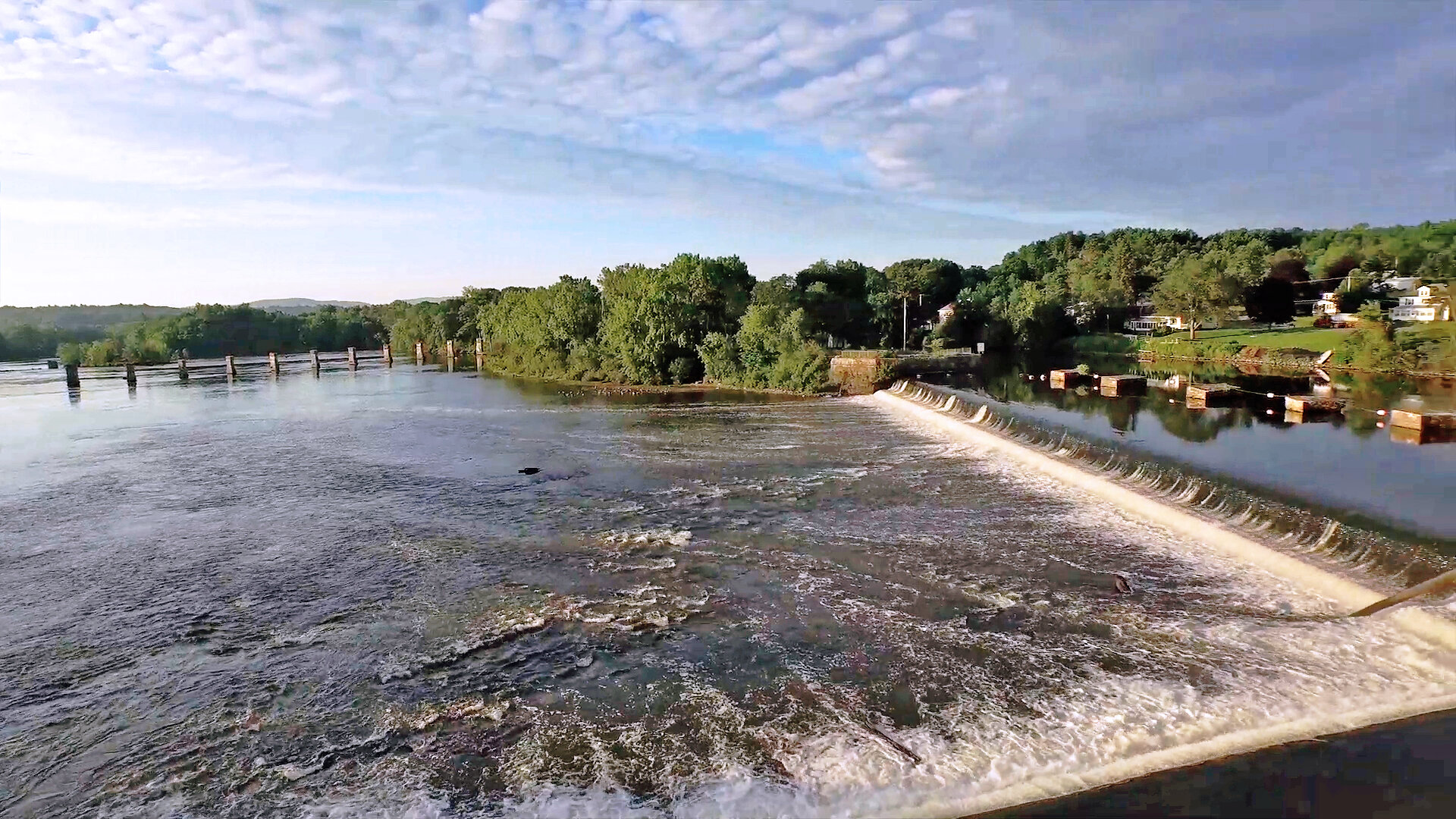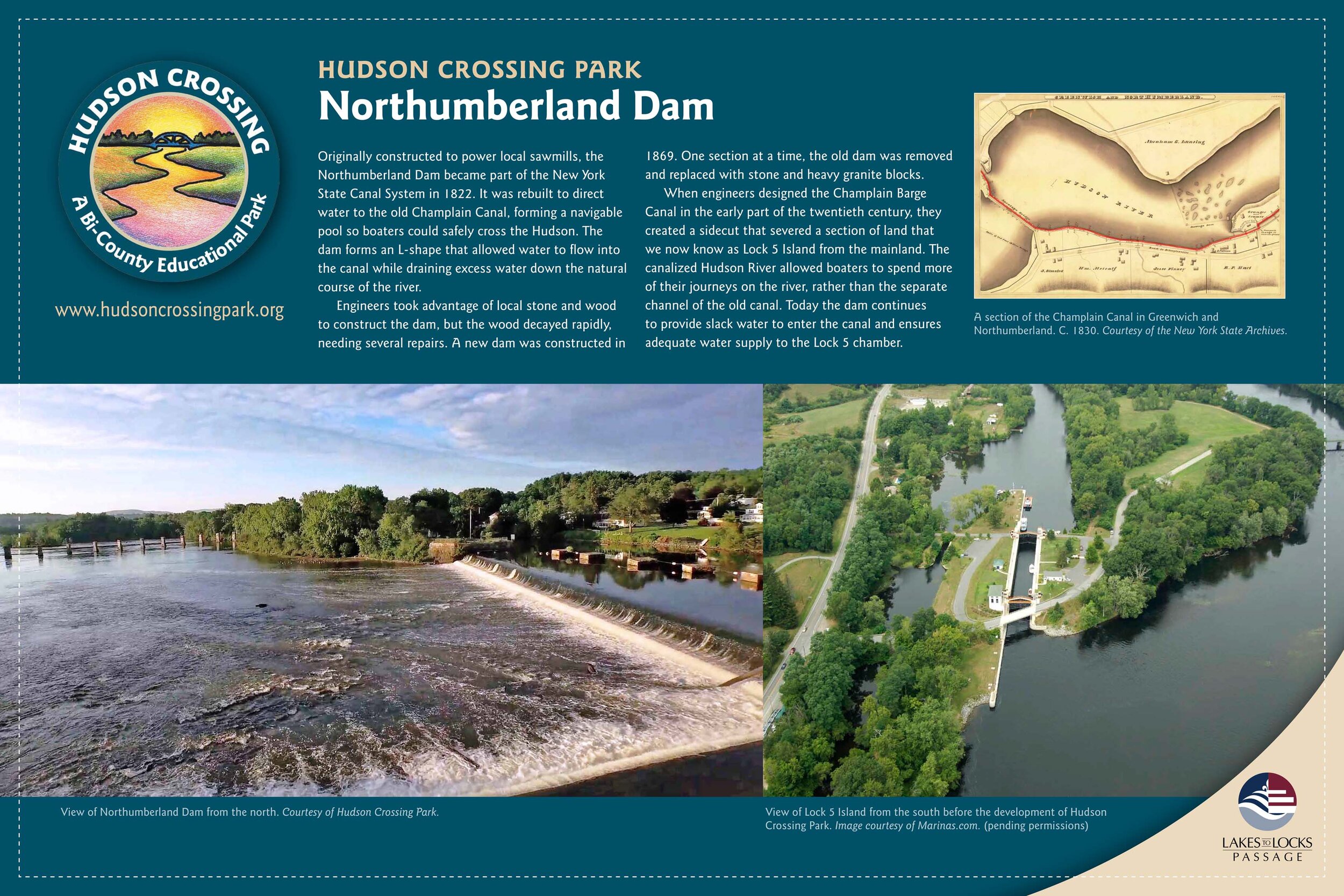The Northumberland Dam, which creates the Saratoga Falls, visible from the Saratoga Falls Park, located approximately one mile north of the entrance of Hudson Crossing Park, or from the point the end of the Eagle Point Trail, and serves as another unique feature of Hudson Crossing Park.
When the Champlain Canal was constructed in the early part of the 19th century, crossing the river by an aqueduct was too expensive, so engineers decided the canal could cross the Hudson in the same way it crossed the Mohawk River: by means of a “slack-water” crossing. Their design moved the tow path to the west bank of the river and up to the bridge that was located near where the bridge is today. Animals would cross the bridge and tow their boats across the current to the next lock.
Benson J. Lossing’s 1866 Drawing of the Saratoga (Northumberland) Dam
Replica Lock Tender’s Shanty at Eagle Point
While the dam made crossing the Hudson easier by decreasing its current and was an economical solution, it was not without dangers. Benson J. Lossing’s 1866 “The Hudson from the Wilderness to the Sea” mentions “When we visited the spot, a large-class boat lay wrecked in the rapids below, having gone over the dam the day before.” A second reference to a boat wreck was collected by local historian Mrs. J. B. Vanderwerker. A resident in 1927 shared a story with her about a flood in 1872 and a canal boat, …”named ‘The Weatherbee’ from Whitehall, loaded with iron ore that locked into the river from the north and was towed to the west side of the River. The water was knee-deep on the towpath. The Captain's wife and child were on the boat. The Captain went ashore with a large rope to tie the boat so that it would not ‘go over’ the dam. The rope broke, and the boat headed for the dam. Elijah Freeman, the lock tender, took a boat and went to the rescue of the woman and child. As he rowed alongside the canal boat, he shouted to the woman and child to jump. They did, but missed the small boat, fell into the rushing waters and all three drowned. “
Based on this story, the Hudson Crossing Park Board of Directors originally planned to dedicate a replica locktender’s shanty, built by Schuylerville High School students and placed in the vicinity of Lock 10, to Elijah for his heroism, but it was soon discovered that this account was not entirely accurate. Thanks to research shared with Hudson Crossing’s Board, it was discovered that the source of the story was a memory shared by a local resident for whom time had apparently blurred some details.
Most of the references indicated that the Lock Tender’s name was indeed Elijah. An article in the Plattsburg Sentinel, told that the tragedy occurred in 1869 with a canal boat named the Witherbee that belonged to Silas H. Witherbee, a wealthy mine owner. Another article indicated that the lock tender survived by staying in his boat.
To find a source for the correct date, research continued, and an event found in the Champlain Canal Legal and Historical Events 1791 - 1905 stated: “1869 Saratoga dam partly carried away during a great freshet.” There were no references to repairs to the area in the list of entries for 1872. Since damage, due to high water, occurred in 1869 but not in 1872 and the storyteller placed the flood and the tragedy in the same year, it was concluded that the Sentinel carried the correct year. A local historian for the village of Schuylerville, Kristina Saddlemire, shared that census records demonstrated that Elijah did survive the incident. “Elijah was married to a woman named Harriet, and they had no children. They removed to Saratoga Springs, where Elijah died between the years of 1910 and 1920. Elijah Freeman owned property in Saratoga Springs on Ludlow Street, and was listed as a Saloon Keeper.”
Today the dam remains a popular attraction for those visiting Hudson Crossing Park and as well as those enjoying a scenic drive through the Northumberland countryside, although most are unaware of the history, tragedy, ingenuity, and mystery, that it has been a part of.




